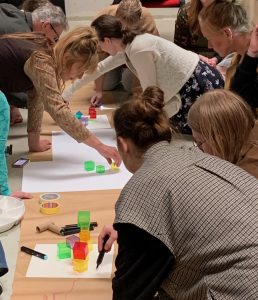Introduction
How do we create a dialogue space where everyone’s voice can be heard and seen? A space where differences are not dismissed or magnified, but are the subject of dialogue? A dialogue where all the senses are engaged, where there is making and moving and not just speaking, an imaginative dialogue? Performative, visual, narrative, auditive and embodied.
How do you actually listen to the other person, suspend your opinions, and question your assumptions? This is not easy, but necessary for living together. The arts can be a way of exploring such dialogues.
Between 2020 and 2023 a three-year Erasmus Plus Strategic Partnership took place between four universities in northern Europe. This project aimed to develop a pedagogy for the questions mentioned above: A Pedagogy of imaginative dialogues.
We named the project PIMDI.
PIMDI explores and develops possibilities offered by the arts and arts education to keep dialogue open and fruitful in an increasingly globalized and polarized world. Rather than opinions and views, PIMDI is about making differences in perceptions and experiences visible. The intention is not to resolve or mediate these differences and tensions but to explore them in a fruitful and non-violent manner. By exploring (embodied) knowledge the act of valuing emerges. In PIMDI we explore imagination as a way of becoming aware of everyone’s voice and to be able to explore different perspectives.
‘Imaginative dialogue does mean using our imagination to develop many ways of having a dialogue also when it is difficult to have one.’ (Quote of a participant after the first intensive week)
In the article “Why do we need a pedagogy of imaginative dialogues?” (forthcoming), four PIMDI researchers Anundsen, Waage, Boven and Anttila delve into three fundamental notions for PIMDI: dialogue, imagination, difference, and valuing.
Regarding the notion of dialogue, the central idea of PIMDI is to explore the encounter with another human or other- than- human being. Dialogue involves the creation of something new through shared exploration. The notion of imagination refers to the artistic forms and strategies that can challenge and enliven the encounter, making the interaction tangible, visible and playful. Furthermore, imagination draws attention to the sensory, embodied, and concrete experience. It encourages participants to embrace the richness and ambiguity of aesthetic encounters.
The PIMDI project involves the collaboration of four Master’s programmes in arts and arts education that pay close attention to dialogue and polyphony within their own curriculum. All programmes are transdisciplinary.
From the expertise of each master’s course and the experience gained in four intensive study weeks, components for a PIMDI curriculum have been developed.

Intensive week in Kristiansand, April 2022. Photo: Gudrun Beckmann
Whereas a curriculum is often constructed top-down from previously defined learning outcomes and intended knowledge and skills, with PIMDI we mainly want to create a curriculum as a field or a space, literally a dialogue space, in which exploration and (transformative) learning can take place. We work inductively, bottom up. From the embodied experiences in mixed student groups during the intensive weeks, we identified starting points and components for a PIMDI pedagogy and curriculum. This way of working fits with our vision of dialogue as an explorative process that takes us from what we think we know to perceiving and embracing what we do not know.
In addition, it fits with the dual perspective of being a master’s student and an artist educator. The imaginative and dialogic exploration of differences in the student group provides insights and starting points for designing and conducting imaginative dialogues with participants in different arts/educational/social contexts and sensitizes the experiences which are undergone as meaningful in the context of art pedagogy.
Similarly, we can see the entire intensive week in which students and teachers work to explore and design imaginative dialogues as an art pedagogical dialogue space itself – as a playing field for awareness of the active components and inner movements.
Starting points for a PIMDI curriculum
1. In PIMDI learning starts with noticing something that catches your attention, that disturbs or touches you. It starts with the discovery of a feeling of engagement. Learning does not begin as purposeful action. It starts in the middle, in the encounter with something unknown. The outcome is uncertain.
2. A PIMDI curriculum does not define learning activities with learning outcomes but creates space and conditions to engage in imaginative dialogues, without knowing or aiming at predetermined outcomes. The pedagogical paradox of a safe space versus the risks of working with uncertainty is an active part of the module.
3. There is attention to the ways in which one gives and creates space. Therefore, we use frameworks and guidelines as enabling constraints and propositions. They are concurrently very specific and yet open.
4. The curriculum is not structured in a linear way, but in an iterative and dynamic way. It continuously revolves around challenging experiences, imagining experiences, and sharing imaginations, while co-creating with these imaginations and reflecting on the multifaceted meanings that emerge.
5. PIMDI is not a new method but a deepening of existing art pedagogy approaches. Giving attention, time, and space to vulnerable (or sensitive) intercultural and interdisciplinary collaborations provides a context for further exploration of dialogical approaches when engaging with challenges and discomforts potentially found in interculturality.
Finally, we want to enable a PIMDI approach for different contexts. This is especially true for the master’s students themselves, who develop imaginative dialogues for different participants within their practice as artist educators.
